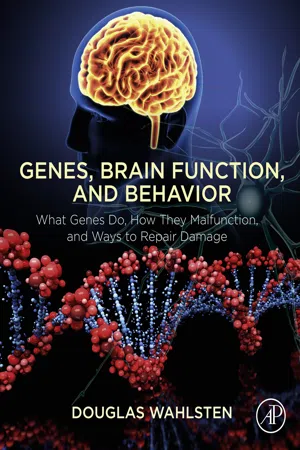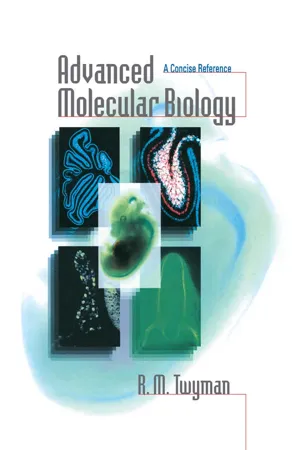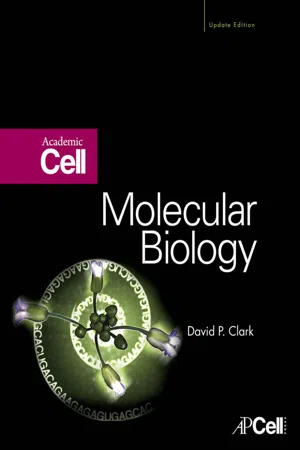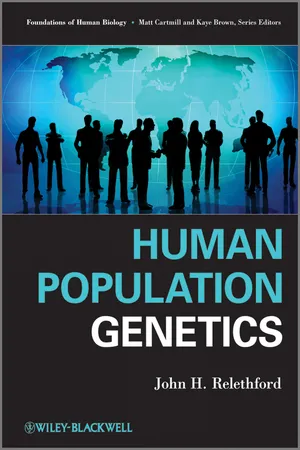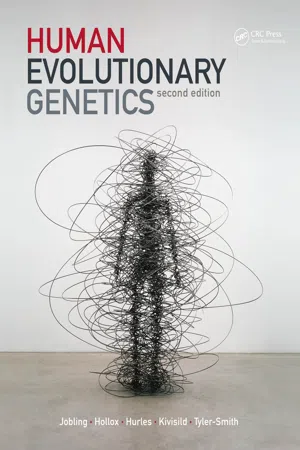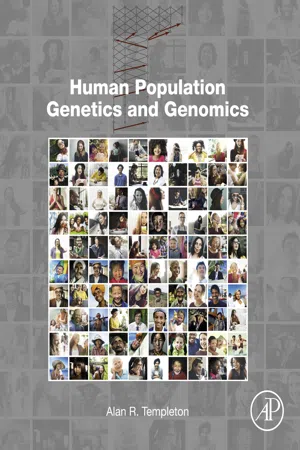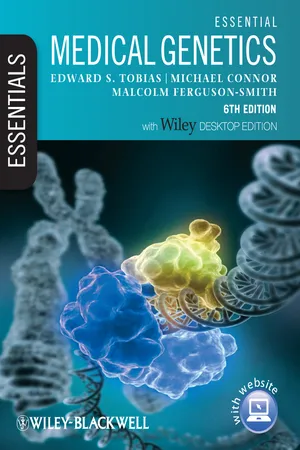Biological Sciences
Alleles
Alleles are different forms of a gene that can occupy the same position, or locus, on a chromosome. They can vary in their DNA sequence and can result in different traits, such as eye color or blood type. Alleles are inherited from each parent and can be dominant or recessive, influencing the expression of specific traits in an organism.
Written by Perlego with AI-assistance
7 Key excerpts on "Alleles"
Learn about this page
Index pages curate the most relevant extracts from our library of academic textbooks. They’ve been created using an in-house natural language model (NLM), each adding context and meaning to key research topics.
- eBook - ePub
Genes, Brain Function, and Behavior
What Genes Do, How They Malfunction, and Ways to Repair Damage
- Douglas Wahlsten(Author)
- 2019(Publication Date)
- Academic Press(Publisher)
heterozygous .- •
Genome sequencing of an individual is revealing large numbers of previously unknown Alleles of the same gene. For many genes, more than 100 Alleles are known that can significantly impair gene function. Most of them are quite rare in a population.- •
Many genes show pleiotropy , whereby the same gene alters many different phenotypes. Pleiotropic gene action is observed by studying mutations that alter the phenotypes.- •
Germ cells get only one allele as a result of meiosis. Which allele is transmitted to offspring via the egg or sperm is a random or chance event. Which two Alleles are paired in the new individual is also a chance event. Which allele is carried by the sperm and which is carried by the egg are independent events.- •
Laws of genetic transmission allow us to estimate the probabilities of obtaining various genotypes among the offspring of two parents having specific genotypes. These laws are important for genetic counseling in which risks of having an affected child are estimated. - eBook - ePub
Advanced Molecular Biology
A Concise Reference
- Richard Twyman(Author)
- 2018(Publication Date)
- Garland Science(Publisher)
Box 1.1 ). Mendel’s principles of inheritance can be summarized as follows.(1) The heredity and variation of characters are controlled by factors, now called genes, which occur in pairs. Mendel called these factors Formbildungelementen (form-building elements).(2) Contrasting traits are specified by different forms of each gene (different Alleles).(3) When two dissimilar Alleles are present in the same individual (i.e. in a heterozygote), one trait displays dominance over the other: the phenotype associated with one allele (the dominant allele) is expressed at the expense of that of the other (the recessive allele).Table 1.1: Definitions of some common terms used in transmission geneticsTerm Definition Allele Broadly, a variant form of a gene specifying a particular trait. At the molecular level, a sequence variant of a gene (q.v. wild-type allele, mutant allele, polymorphism) Character A biological property of an organism which can be detected or measured Character mode A general type of character, e.g. eye color Character trait, trait, variant A specific type of character, e.g. blue eye color Gene Broadly, a hereditary factor controlling or contributing to the control of a particular character. At the molecular level, a segment of DNA (or RNA in some viruses) which is expressed, i.e. used to synthesize one or more products with particular functions in the cell (q.v. gene, cistron, gene expression) (Gene) locus The position of a gene (or other marker or landmark) on a chromosome or physical or genetic map. A useful term because it allows discussion of genes irrespective of genotype or zygosity Genetic Pertaining to genes. Of characters, heredity and variation arising from the nucleotide sequence of the gene (cf. epigenetic, environmental - eBook - ePub
- David P. Clark(Author)
- 2009(Publication Date)
- Academic Cell(Publisher)
Alleles , which code for different versions of a particular inherited character (such as red versus white flower color). The different Alleles of the same gene are closely related, but have minor chemical variations that may produce significantly different outcomes.The overall nature of an organism is due to the sum of the effects of all of its genes as expressed in a particular environment. The total genetic make-up of an organism is referred to as its genome . In lower organisms such as bacteria, the genome may consist of approximately 2,000 to 6,000 genes, whereas in higher organisms such as plants and animals, there may be up to 50,000 genes.Etymological NoteMendel did not use the word “gene.” This term entered the English language in 1911 and was derived from the German “Gen,” short for “Pangen.” This in turn came via French and Latin from the original ancient Greek “genos,”which means birth. “Gene” is related to such modern words as gen us, origin , gene rate, and gene sis. In Roman times, a “genius” was a spirit representing the inborn power of individuals.allele One particular version of a gene gene The entire genetic information genome The entire genetic information of an individual organism Gregor Mendel Discovered the basic laws of genetics by crossing pea plants Mendelian character Trait that is clear cut and discrete and can be unambiguously assigned to one category or another Genes Determine Each Step in Biochemical Pathways
Mendelian genetics was a rather abstract subject, since no one knew what genes were actually made of, or how they operated. The first great leap forward came when biochemists demonstrated that each step in a biochemical pathway was determined by a single gene. Each biosynthetic reaction is carried out by a specific protein known as an enzyme . Each enzyme has the ability to mediate one particular chemical reaction and so the one gene —one enzyme model of genetics (Fig. 1.02 - eBook - ePub
- John H. Relethford(Author)
- 2012(Publication Date)
- Wiley-Blackwell(Publisher)
A population might not be at Hardy–Weinberg equilibrium because of deviations due to nonrandom mating (inbreeding, assortative mating) and/or action of one or more of the evolutionary forces (mutation, natural selection, genetic drift, gene flow). An importance difference is that nonrandom mating causes changes in genotype frequencies but not allele frequencies, whereas the evolutionary forces lead to changes in both genotype and allele frequencies. We start with a consideration of the genotypic impact of inbreeding as a form of nonrandom mating in the next chapter, and then move on to separate chapters on the different evolutionary forces. These different factors will be discussed initially one at a time to get the concept across, and then combined where appropriate.Keep in mind that although this approach focuses on one factor at a time, in reality all of these deviations from Hardy–Weinberg equilibrium can be operating at the same time. As I often tell my students in my introductory class, the good news is that there are only four evolutionary forces, making exam review easier. However, the bad news as far as researchers are concerned is that these forces (along with nonrandom mating) can interact in many, often very complex, ways. It becomes a problem (or challenge, depending on how you look at it) to untangle these effects, particularly when dealing with the culturally complex, highly mobile, and rapidly changing human species.2.7 SummaryGenes and DNA sequences have different forms, known as Alleles . When we look at microevolution, we are interested in how the relative frequency of Alleles can change over time. When the field of genetics was just beginning, some researchers wondered why dominant Alleles did not increase to completely replace recessive Alleles over time. This question led to a deeper understanding of the mathematical application of Mendel's ideas on a populational basis. In 1908, mathematician Godfrey Hardy and physician Wilhelm Weinberg independently derived a mathematical relationship between allele and genotype frequencies, and further showed that, under certain conditions, the allele and genotype frequencies would remain the same generation after generation. For a locus with two Alleles, A and a , with allele frequencies p and q , respectively, the genotype frequencies in the next generation will be AA = p 2 , Aa = 2pq , and aa = q 2 . Under certain conditions, the allele and genotype frequencies will remain the same over time.This principle, known as Hardy–Weinberg equilibrium - eBook - ePub
- Mark Jobling, Edward Hollox, Toomas Kivisild, Chris Tyler-Smith(Authors)
- 2013(Publication Date)
- Garland Science(Publisher)
Chapter 17 ).Does selection or drift determine the future of an allele?
So far in this section we have not considered the interplay between selection and drift, and their relative weight in influencing allele frequencies. For example, the selection dynamics described inassume an infinitely large population. What happens in finite populations where random genetic drift is also operating?Section 5.4Because drift operates more effectively in smaller populations, stronger selection is required to influence fixation or elimination of Alleles. Whether drift or selection predominates depends on a number of factors, which include:•The effective population size •The selection coefficient •The type of selection •The frequency of the allele under selectionEquations relating these parameters exist for different types of selection. They can be used to determine whether an allele is likely to be under the influence of selection. Relating these parameters together allows us to draw four important conclusions:•Selection often substantially increases the probability that an advantageous allele becomes fixed compared to a neutral allele; in humans, most new advantageous Alleles are still far more likely to be eliminated than fixed.•If new Alleles are almost exclusively deleterious, the optimal allele can persist unchanged over very long time-scales. This conforms to the hypothesis that functional constraint on important proteins such as histones underlies their extreme lack of variability among diverse species. - eBook - ePub
- Alan R. Templeton(Author)
- 2018(Publication Date)
- Academic Press(Publisher)
T , found in these 334 nucleotides are:- Number of C Alleles: 102 × 2 + 56 × 1 + 9 × 0 = 260
- Number of T Alleles: 102 × 0 + 56 × 1 + 9 × 2 = 74
Note that the allele count is determined by the genotype numbers multiplied by the number of copies of the allele of interest borne by individuals with a specific genotype. The gene pool is now described by the allele frequencies that are derived by dividing the allele counts by the total number of sampled genes (or nucleotides, in this case):- Frequency of C allele: 260/334 = 0.778
- Frequency of T allele: 74/334 = 0.222
These allele frequencies are the essential description of the Ashkenazi gene pool for this nucleotide. Similarly, the allele frequencies in the sub-Saharan African population are: (5 × 2 + 16 × 1 + 85 × 0)/212 = 0.123 for the C allele and (5 × 0 + 16 × 1 + 85 × 2)/212 = 0.877 for the T allele.An alternative definition of the gene pool is the population of potential gametes that can be generated from the individuals of the deme. This definition is illustrated in Fig. 1.2 for the Ashkenazi Jewish population. Starting with the population of diploid individuals as characterized by genotype frequencies, the rules of inheritance are applied to each genotypic class to predict the probabilities of all the types of gametes each genotype can produce. Assuming that there is no mutation and normal meiosis, the CC homozygote will produce C -bearing gametes with a probability of 1, and T- bearing gametes with a probability of 0. Similarly, the TT homozygote will produce C -bearing gametes with a probability of 0 and T- bearing gametes with a probability of 1. Given no mutation and normal meiosis, the only rule of inheritance that is relevant to the CT heterozygotes is Mendel's first law of segregation, which states that the probability of a C- bearing gamete is ½ and the probability of a T -bearing gamete is ½. These meiotic probabilities assigned to each diploid genotype are transition probabilities; that is, they describe the probabilities by which a given diploid genotype produces a given haploid gamete type through the process of meiosis. The transition arrows shown in Fig. 1.2 illustrate this. The genotype frequencies and the meiotic transition probabilities are sufficient to calculate the allele frequencies in the population of gametes, as shown in Fig. 1.2 - eBook - ePub
- Edward S. Tobias, Michael Connor, Malcolm Ferguson-Smith(Authors)
- 2011(Publication Date)
- Wiley-Blackwell(Publisher)
Appendix 3 Population genetics of single-gene disorders Maintenance of gene frequenciesIn a population, the relative frequencies of different Alleles tend to be kept constant from one generation to the next. This can be demonstrated mathematically and helps to explain why dominant traits do not automatically increase at the expense of recessive traits.Consider one autosomal locus with two alternative Alleles, A and a. If the frequency of the allele A is p and the frequency of the allele a is q, then the sum of these allele frequencies must be 1, or 100%. Therefore:Table A3.1 shows the frequencies of each genotype at this locus.In the production of the next generation, each of the three types of paternal genotype may mate with each of the three types of maternal genotype (Table A3.2 ). Table A3.3 indicates the genotypes of the offspring for each mating type, and as can be seen, the relative frequency of each remains unchanged and the population is said to be in genetic equilibrium. Although the actual numbers of individuals with each genotype may have increased, the relative proportions of each genotype (and allele) have remained constant (AA at/>2 , Aa at 2pq and aa atq2 ).This principle is called the Hardy–Weinberg law.Table A3.1Allele and genotype frequencies at a locus with two Alleles, A and aMaternal gametes Paternal gametes A (p ) a (q ) A (p ) AA (p 2)Aa (pq ) a (q ) Aa (pq ) aa (q 2)Table A3.2Frequencies of different parental genotypes at reproductionThe most important application of this law is the calculation of carrier frequencies for autosomal recessive traits.Table A3.3Frequencies of different types of offspring after reproductionFor any autosomal recessive trait, if q is the frequency of the mutant allele and p the frequency of the normal allele, then the frequency of the recessive homozygote genotype is equal to the square of the mutant allele frequency(q2 ), or the disease frequency (for a condition with childhood onset). Thus, for cystic fibrosis: recessive homozygote frequency,q2=1/1600. Therefore, q = √(l/1600) = 1/40. Consequently, as above, p = 1 — q = 39/40. The heterozygote (carrier geno- type) frequency is 2pq,
